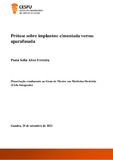| dc.contributor.advisor | COELHO, LARA SOFIA BARROS | |
| dc.contributor.author | Ferreira, Paula Sofia Alves | |
| dc.date.accessioned | 2022-03-08T11:59:53Z | |
| dc.date.available | 2022-03-08T11:59:53Z | |
| dc.date.issued | 2022 | |
| dc.identifier.uri | http://hdl.handle.net/20.500.11816/3895 | |
| dc.description.abstract | A reabilitação oral implanto suportada, pode ser feita mediante coroas aparafusadas (CA) ou cimentadas (CC).
O objetivo deste trabalho consiste em analisar algumas características mecânicas e biológicas de ambas as opções tais como: o índice de placa (IP), índice de sangramento (IS), mucosite, periimplantite, perda óssea (PO), fratura (F), chipping e o desaperto do parafuso. Realizou-se uma pesquisa bibliográfica na pubmed usando uma restrição temporal de 10 anos incidindo nos estudos clínicos, em inglês e em humanos.
Relativamente aos resultados: o IP foi superior em CC devido à dificuldade de remoção e como consequência acumula mais placa bacteriana. Em relação ao IS foi igual nas CC e CA, a mucosite e a perimplantite foi mais frequente em CC derivado à inflamação dos tecidos, devido ao excesso de cimento. O aspeto biológico PO foi mais frequente em CA. O desaperto do parafuso e a F da cerâmica foi mais frequente em CA, em relação ao chipping foi mais frequente em CC, sendo que os valores não são estatisticamente significativos.
Cada método de retenção tem as suas vantagens e desvantagens fazendo com que a sua escolha dependa das caraterísticas e necessidades de cada paciente.
Com este trabalho foi possível concluir que não é possível determinar qual a melhor alternativa protética para as próteses fixas sobre implantes. A resposta a esta discussão só é possível de ser obtida após uma exaustiva avaliação de cada caso de reabilitação, ponderando as vantagens e desvantagens de cada técnica, não havendo uma resposta geral para qual o melhor tipo de retenção, podendo levar a diferentes tipos de conclusões. | pt_PT |
| dc.description.abstract | Implant-supported oral rehabilitation can be performed using screw-retained or cemented crowns.
The objective of this work is to analyze some mechanical and biological characteristics of both options, such as: plaque index, bleeding index, mucositis, periimplantitis, bone loss, fracture, chipping, and screw loosening of the prosthetic abutment. A literature search was performed at pubmed using a 10-year time restriction focusing on clinical trials in English. Regarding the results.
The PI was higher in CC because they are difficult to remove and, as a consequence, accumulate more bacterial plaque. In relation to IS, it was the same in CC and AC, and the lack of oral hygiene was due to the accumulation of cement.
In this study, we also evaluated mucositis and periimplantitis, where tissue inflammation was more frequent in CC due to excess cement. The PO biological aspect was more frequent in CA.
In the present studies, screw loosening and ceramic F was more frequent in AC, compared to chipping it was more frequent in CC, but always bearing in mind that, in general, the values are not statistically significant.
Each retention method has its advantages and disadvantages, so that the choice of the best method depends on the characteristics and needs of each patient.
With this work, it was possible to conclude that it is not possible to specify the best prosthetic alternative for fixed prostheses on implants. The answer to this discussion can only be obtained after an exhaustive evaluation of each rehabilitation case, weighing the advantages and disadvantages of each technique, with no general answer for which is the best type of retention, which may lead to different types of conclusions . | pt_PT |
| dc.language.iso | por | pt_PT |
| dc.rights | info:eu-repo/semantics/openAccess | pt_PT |
| dc.subject | Implant | pt_PT |
| dc.subject | Screw retained | pt_PT |
| dc.subject | Cimented | pt_PT |
| dc.subject | Crown | pt_PT |
| dc.subject | Prothesis | pt_PT |
| dc.title | Prótese sobre implantes: cimentada versus aparafusada | pt_PT |
| dc.type | info:eu-repo/semantics/masterThesis | pt_PT |
| dc.identifier.tid | 202948390 | pt_PT |
| thesis.degree.name | Mestrado em Medicina Dentária | pt_PT |

